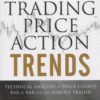THE ART AND SCIENCE OF TECHNICAL ANALYSIS
$95.00 Original price was: $95.00.$59.95Current price is: $59.95.
Covers a broad swath of technical trading topics, including: How To use your charts to best capitalize on the supply/demand dynamics that move markets…Specific trading patterns used profitably for over a decade by the author…Practical probability theory…Tools for confirmation, and much more.
Out of stock
DESCRIPTION
(From The Jacket) – Trading is a tough endeavor. And while it’s difficult to derive a method that generates superior risk-adjusted profits in today’s extremely competitive markets, it’s even harder to successfully apply such a method in actual trading. The approach found in “The Art and Science of Technical Analysis” — one which, in many ways, challenges the traditional thinking of technical analysis — can help you achieve this goal.
Written in a straightforward and accessible style, this book breaks away from many of the standard trading books that have come before it. “The Art and Science of Technical Analysis” doesn’t detail a rigid system to be strictly followed, nor does it present a group of setups and patterns that can be quickly assembled by a trader. Rather, it provides comprehensive coverage of the issues you need to be aware of in order to capture consistent profits from technically motivated, directional trading.
Based on nearly two decades of author Adam Grimes’s experience as a trader, analyst, and systems developer, this reliable resource contains valuable insights for both individual and institutional traders, and has been designed with both established and aspiring traders in mind. Divided into four informative parts, it skillfully:
- Explores some of the probability theory supporting the concepts of successful trading, examines a specific approach to chart reading that builds the foundation for a deep intuition about price patterns in markets, and provides an overview of the Wyckoff market cycle
- Offers an in-depth look at the underlying foundation of price movements through coverage of trends, trading ranges, and the transitions from one to the other
- Outlines specific trading patterns and examples of those patterns; advocates a specific way of looking at indicators and other confirming factors; addresses the importance of sizing trades and managing positions; and calls attention to the various risks associated with trading
- Focuses on the elements of trader psychology, from cognitive biases to issues of emotional control, and lays out the challenges that developing traders usually face
Rounding out this discussion are three information-packed appendices. The first is a trading primer that will be useful for developing traders or managers who don’t have a familiarity with the language used by traders. The second expands on some specific details and quirks of moving averages, the MACD, which are used extensively in other sections of the book. And the last appendix contains a list of trade data used in the performance analysis found in Part Four.
What you need to succeed in today’s markets is a verifiable edge. “The Art and Science of Technical Analysis” will give you that edge and put you in a better position to improve your overall trading performance.
TABLE OF CONTENTS
Part 1: The Foundation Of Technical Analysis
- Chapter 1 – The Trader’s Edge
- Chapter 2 – The Market Cycle And The Four Trades
Part 2: Market Structure
- Chapter 3 – On Trends
- Chapter 4 – On Trading Ranges
- Chapter 5 – Interfaces Between Trends And Ranges
Part 3: Trading Strategies
- Chapter 6 – Practical Trading Templates
- Chapter 7 – Tools For Confirmation
- Chapter 8 – Trade Management
- Chapter 9 – Risk Management
- Chapter 10 – Trade Examples
Part 4: The Individual, Self-Directed Trader
- Chapter 11 – The Trader’s Mind
- Chapter 12 – Becoming A Trader
| publication_year | 2012 |
|---|---|
| product_type | Hardcover |
| pages | 463 |
| writer | Adam Grimes |
| orig_products_id | 787 |



